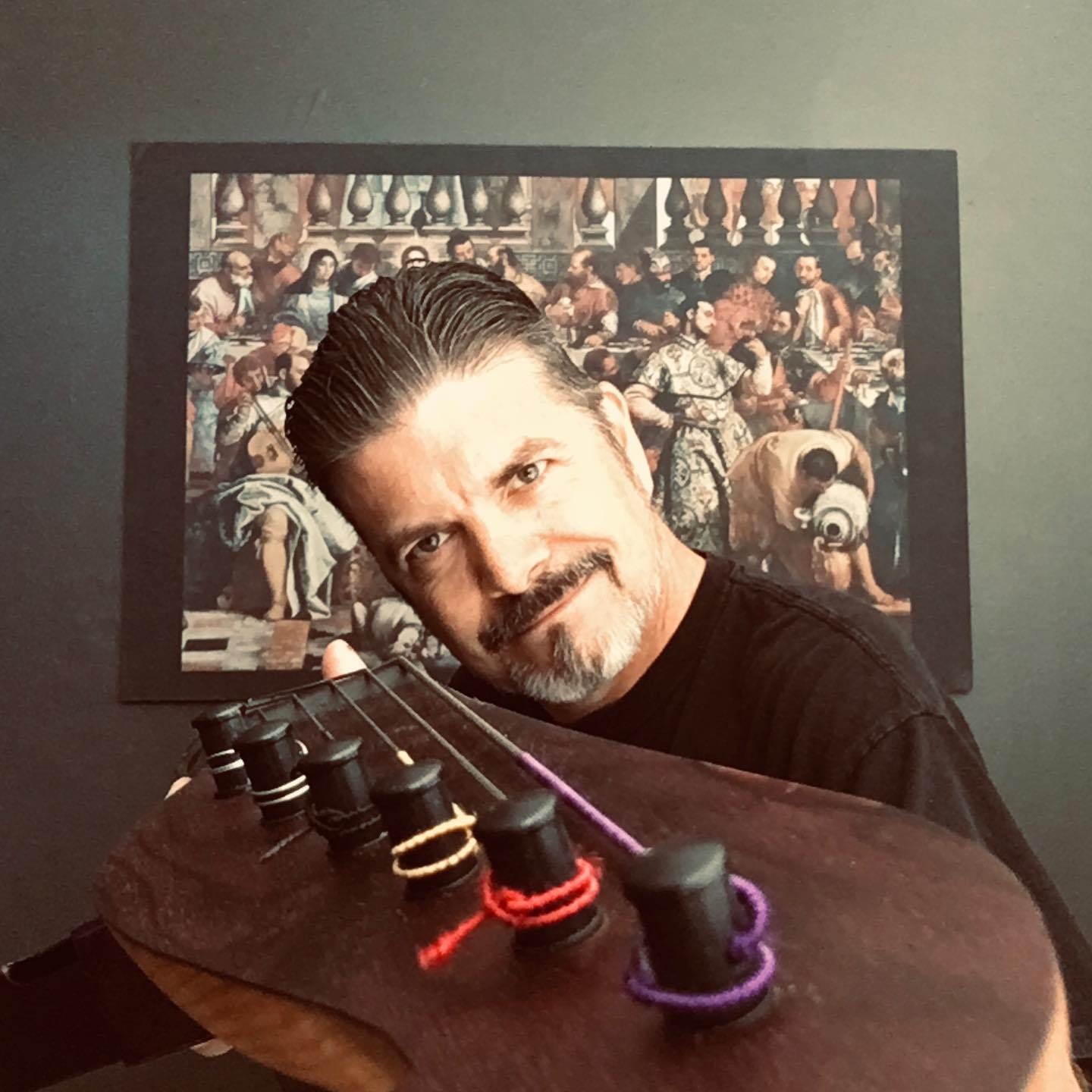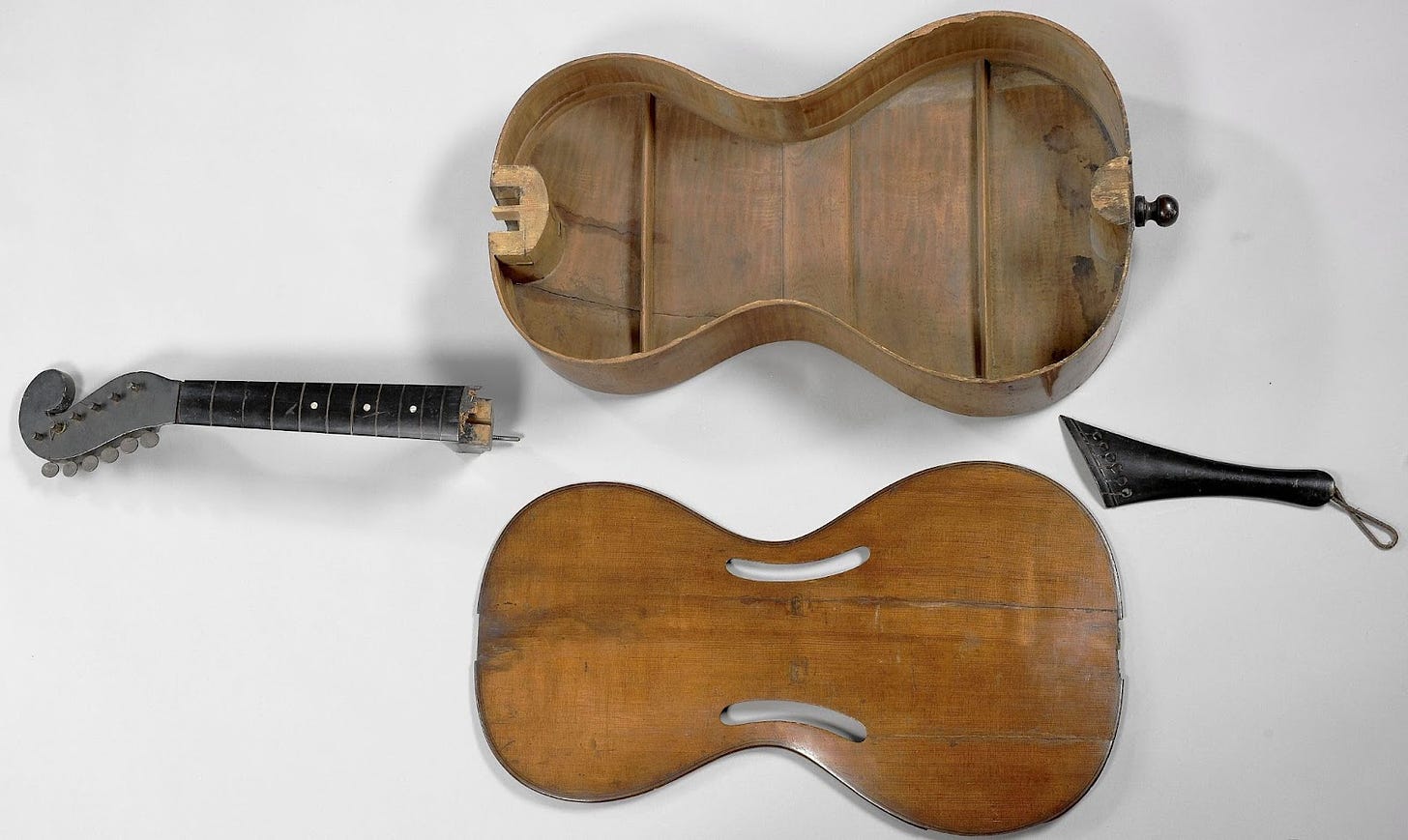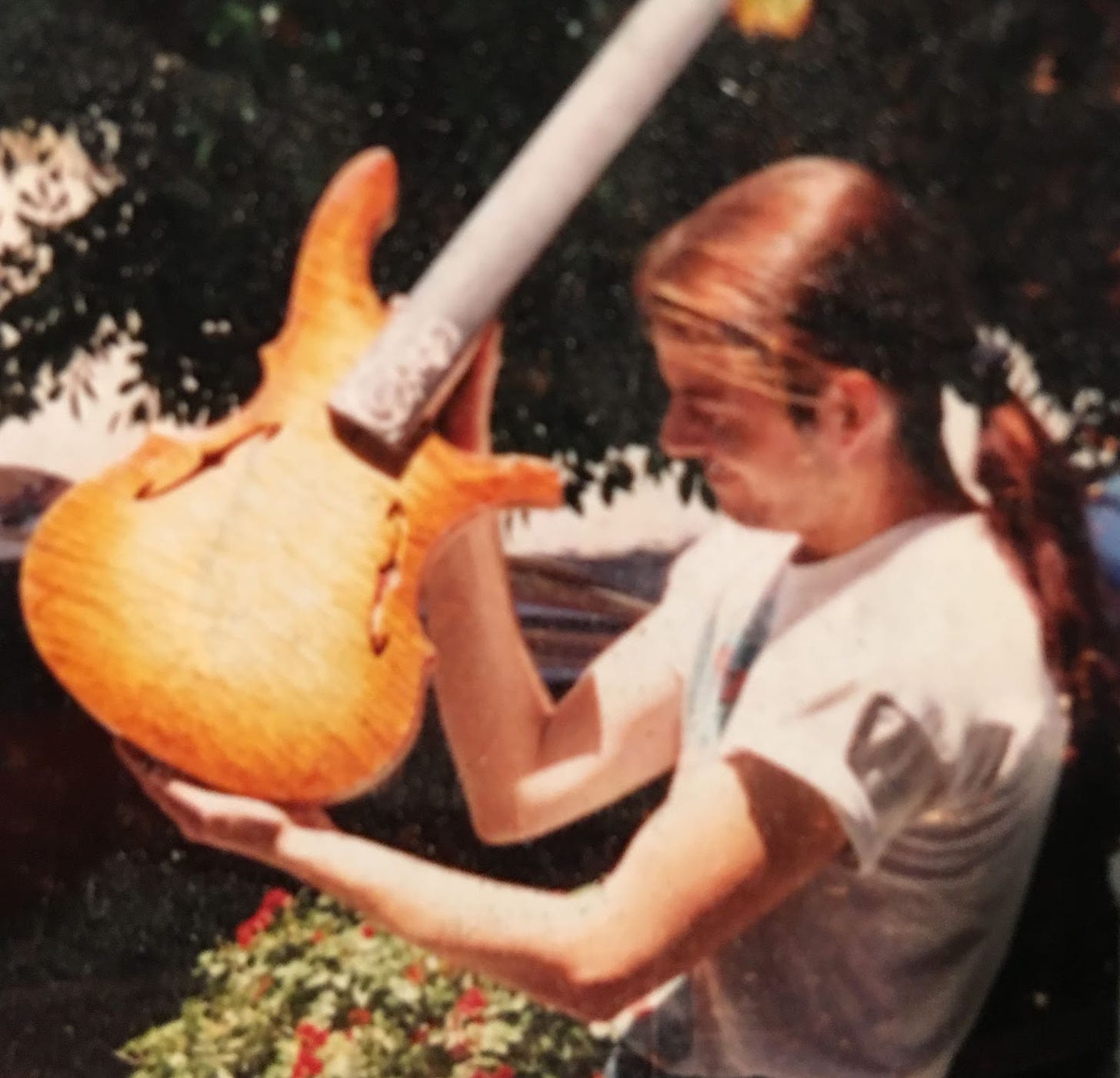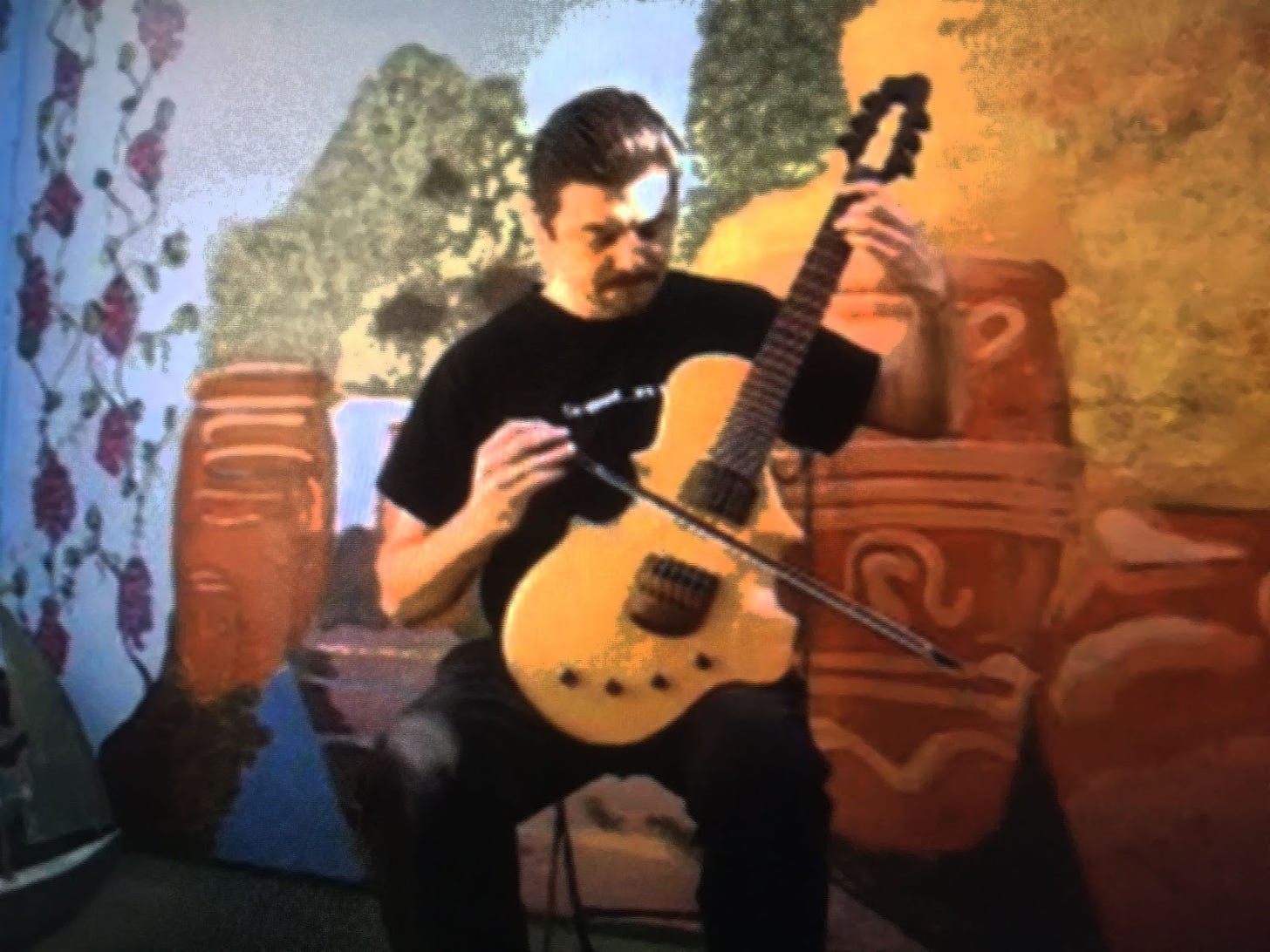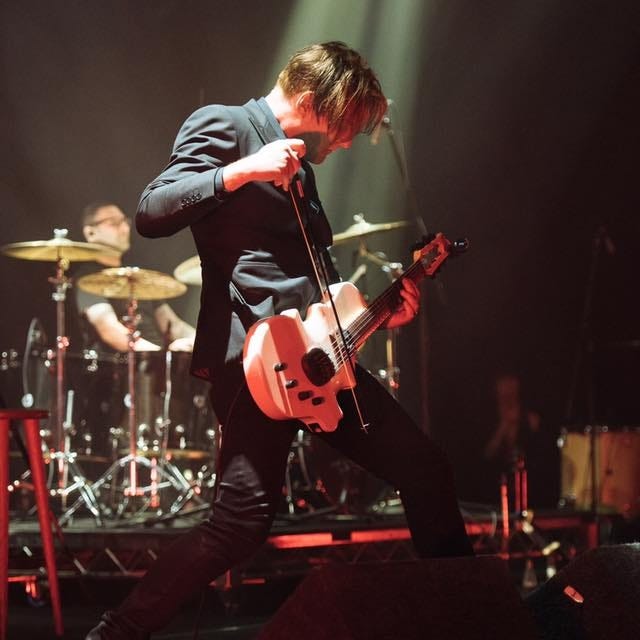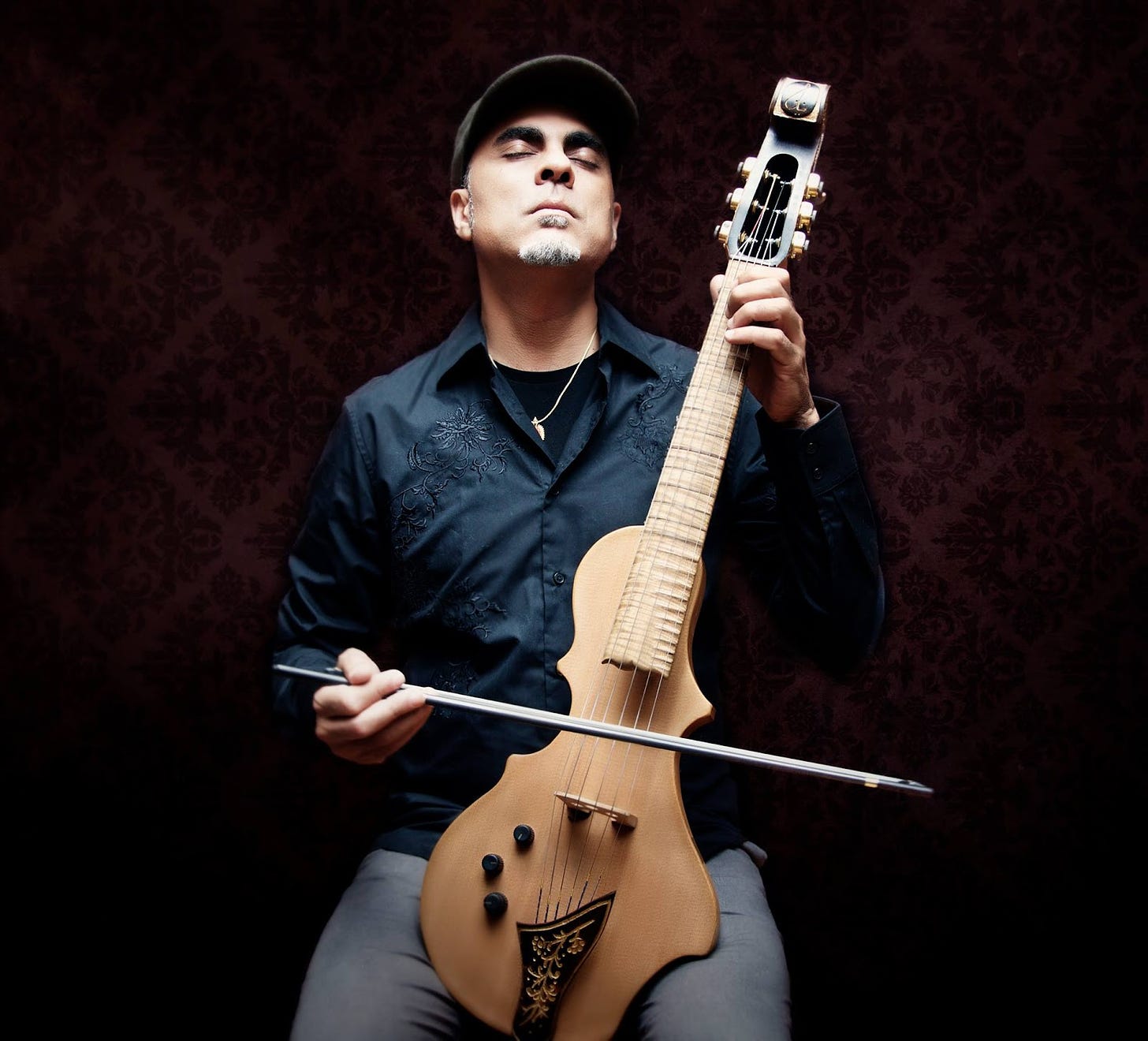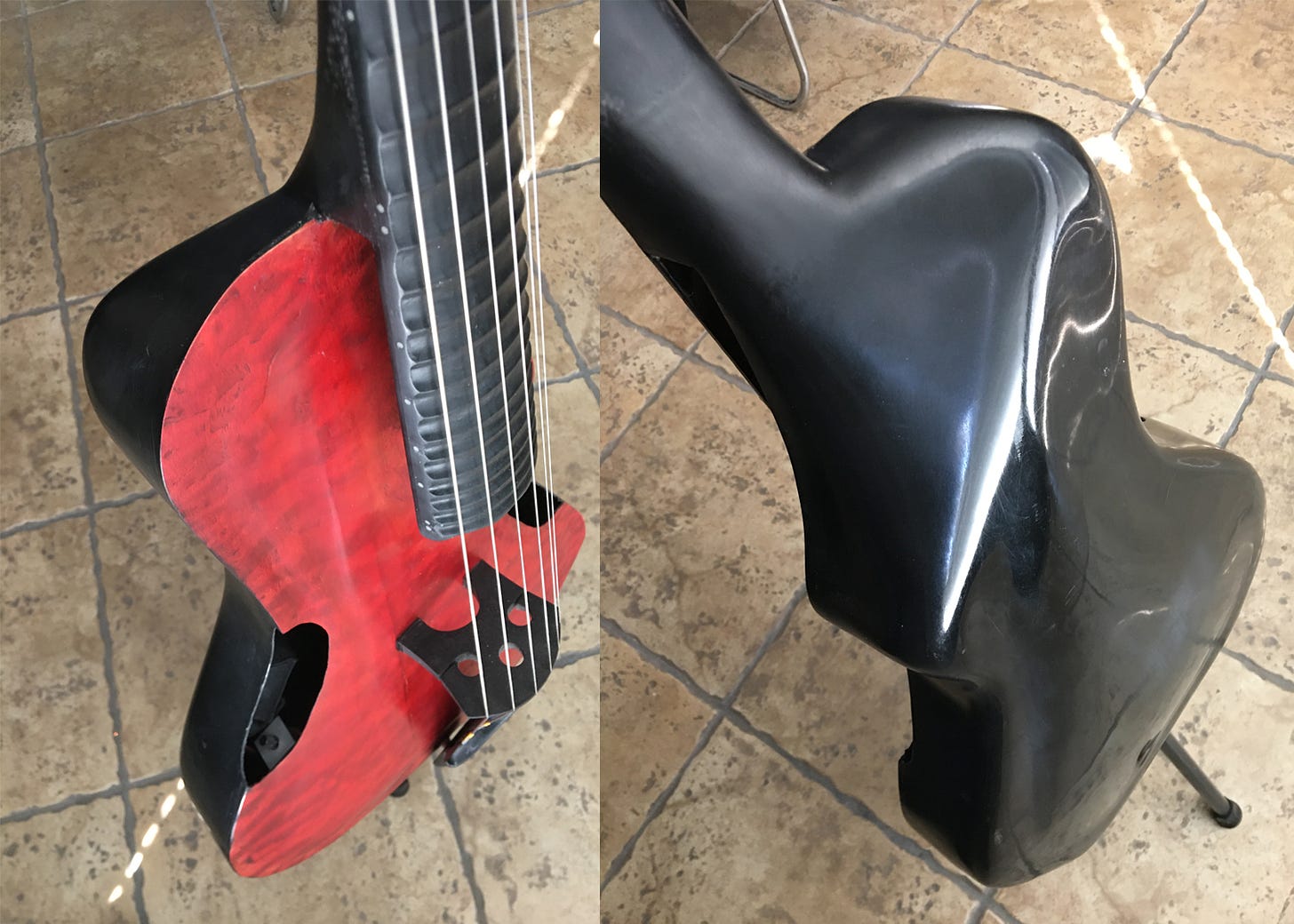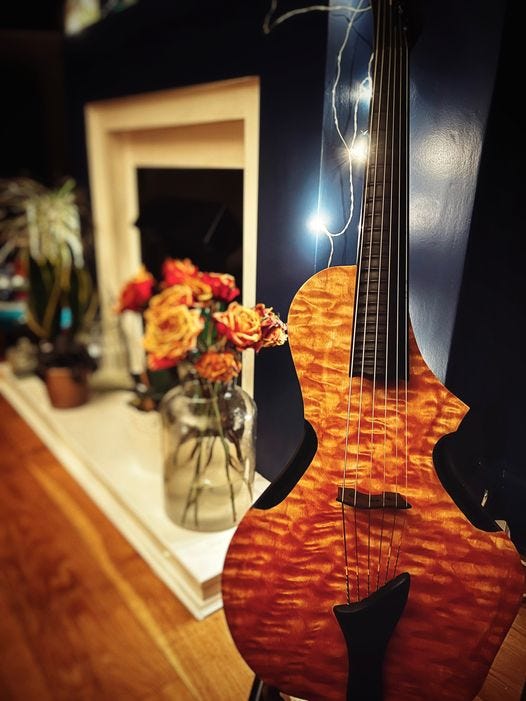Fits and starts; bringing a failed 19th century instrument into the 21st-century!
*an introduction to the rabbit hole.
Fits and starts; bringing a failed 19th century instrument into the 21st-century!
By Jonathan Eric Wilson
A long haired man in a peasant’s linen shirt grabs a bow and wields it to a guitar. Jimmy page in the 1960s? Nope. An Invading Moor applies a Rabab bow to a lute/vihuela in 15th century Spain. (* Lutes and Vihuelas are ancestors to the modern Guitar). The first Viol, Viola da Gamba was born! 600 some odd years before Jimmy page! (Or Eddie Phillips before him, another story). In fact, this “guitar bowing” phenomenon has gone on for centuries and even predates what we know as the modern violin family! Viols were mostly tuned in 4ths and had frets; basically bowed guitars! These instruments were popular for centuries for the same reasons that electric guitars are today. Sustain and sublimely complex harmonics! Think in terms of the overdrive and distortion characteristics of loud amplified guitars since the 1960s. It is like achieving Hendrixian harmonics and feedback without the Marshall stack.
In today’s world, The idea is so old that it seems new! Viols and Viola da Gambas (bowed guitars of the day) eventually faded away in favor of the louder, more efficient, Violin family of the late 1700s and 1800s. Prior to that, Vihuelas (early Spanish guitars) came in two forms: Vihuela de mano (of the hand, plucked) or Vihuela de arco (of the bow, bowed). You see, bowed guitars have always been part of the guitar's story! Vihuela and Viol share the same root word. Notice that the Portuguese word for Classical guitar is “violão”. It’s a big rabbit hole worth exploring! Required viewing: “Tous Les matins du monde”; a 1992 French film depicting the life of Marin Marias and His master San Colombe.
Noces de Cana painting by Paolo Veronese (The painter himself with a treble viol)
Pan ahead to the early 1800’s and a particular bowed guitar/guitar violoncello, called the Arpeggione, was invented by Johan Stauffer in Vienna (1823). You guitarists are already familiar with Stauffer’s influence in guitar building! One glaring example is the “six on a side” tuner headstock pattern that inspired Bigsby and Fender. Stauffer also had an apprentice named CF Martin Who moved his operation to the United States after being harassed by the Austrian/German violin guilds of the day. Though Stauffer died in the poor house, he was arguably one of the most influential guitar builders to ever live. His Arpeggione was ill timed! It came at a time when the similarly 4ths tuned Viola Da Gamba fell out of fashion decades before. Having 24 steel frets (like guitar) and (softer sounding gut strings of the day) did not help matters either! The Arpeggione was apparently a bowed guitar 200 years before it’s time! (Wrong century!) One Stauffer client, a certain Franz Schubert, wrote a sonata called the Arpeggione sonata which is mostly played on cello today (the consensus is that it sounds better on Cello than the original Arpeggione). Many luthier‘s have tried similar (bowed guitar) concepts and failed miserably. There are many reasons this author is personally familiar with!
Disassembled broken Arpeggione. Note the 200 year old Stauffer head-stock design!
I first read about the Arpeggione at the end of the 1980’s. Earlier that same decade, I read about Lol Creme and his Gizmotron (A mechanical Hurdy Gurdy like device that bowed individual strings with wheels by pushing buttons). [Author’s note: The Gizmotron has been re-engineered and re-introduced in recent years.] One of my boarding school teachers, Ron Macfarlane (Yes, Seth Macfarlane’s dad), compared my Stratocaster pinky/volume swell “whale sounds” to that of a cellist. I suppose I took Ron literally and became obsessed with the idea of a truly bow playable guitar! In January of 1989, I read an obscure paragraph in the 1948 encyclopedia about a six string fretted cello tuned EADGBE like a guitar. I jumped off my bed and screamed “F yes! I am going to have my own Arpeggione!” That, my friends, was the moment that defined the next 33 years of my life! (and counting).
Circa 1992 with a ghost built prototype. (I had no idea what I was getting myself into!)
Who in his right mind, would endure decades of fits and starts, to succeed with an instrument with two previous centuries of failure? The road to a successful Arpeggione is littered with the failures of many luthiers who tried! I cannot even begin to tell you the level of snob foolery and sideways looks I have endured all these years! Yet this apparent calling would not leave me be! To make it happen, I had to tune out all manner of bias, tradition, and convention in order to engineer away the bugs. To succeed with it, I had to ignore all naysayers and curmudgeon trolls/sea lions/*Salieris of the trade! (Google “Salieri Syndrome”). I did have a one-off prototype that I played through the 90s. It looked beautiful and sounded beautiful, but there were still some issues to work out!
By Y2K, I returned to the idea of building another one that would solve the ergonomic problems I was having with the earlier one. The first one was built with a 25 ½” scale like a guitar. Unfortunately for the way that I wanted to hold it (my natural heretical semi guitar/da gamba playing stance), the design was causing me physical pain! Rather than design a pretty (or ugly) shape on a piece of paper, this time, I would take a cardboard/foam mock-up and get it to feel right before it went to the drawing board! One day I was setting up a viola at a music store (day job of the day). I played it in my preferred stance since I cannot play it under the chin to save my life! Wow, I could actually play it this way! At that point I revisited the scale length; rigid guitar caveats be damned! I shot right between 25 ½” (guitar) and 16” (viola) settling on 21” from nut to bridge. The body was shaped in the way that I wanted it to sit in my lap. The nut was decidedly at eye level. By the late summer of 2002, The first *TogaMan GuitarViol was born! (Stauffer/Arpeggione sounded too much like frozen Italian dinner To American ears. My last name, Wilson, sounded like sports equipment or sit-com neighbors. *TogaMan was inspired by a toga-wearing viol player in Paolo Veronese’s “Noces de cana” (water to wine painting that is currently exhibited at the Louvre museum in Paris). Think I’ll go water to wine on this one!
Typical 2000’s era solid body in front of my bistro mural of the day.
I had no idea what type of avalanche this would trigger! After all, I was just building my own dream instrument; other people’s opinions be damned! I had no shop or machines to speak of; just a rusty bastard file, a chunk of alder, blistered hands, and a precise vision of my dream instrument! Oddly enough, I had inquiries coming in about my old (ghost built) 90’s era instrument! Armed with a book called “The idiots guide to HTML”, I cobbled together a dial-up era website, took a deposit, and thought to myself “what the hell did I just get myself into?” By the end of 2002, I had yet another inquiry from a certain Loga Ramin Torkian whose subsequent use of my instrument in Hollywood soundtrack studios triggered the next 20 years of year-long + backlogs! Then, there was a watershed moment of it’s prominent use by Tyler Bates in 300! Overnight, players/composers were incensed that I did not have showrooms around the world, a factory, all of the bugs worked out, and a big distribution network or ready instruments “yesterday”. I would spend every day for the next 20 years hand building a manufacturing resistant (higher build difficulty than is practical) instrument for Film/ TV game media composers around the world! For perspective, it is literally difficult to binge watch Netflix, Showtime, or HBO without hearing a GuitarViol somewhere in the score! (Still overwhelmed and wrapping my head around that).
Tyler Bates onstage with the very one heard in 300 and tons of other movies!
It sounds like a fairy tale and the greatest “first world” problem for any luthier to have! (The only problem was that I was not trying to become a dirty bearded luthier! I originally was trying to build a recording career!) The pressure was/is real! The “I want mine yesterday” level of demand was there! (But, also were all the production/development problems standing in the way!) A lot of R&D still needed to be done! The next 20 years would essentially be an incremental crowd funded project that involved continuous problem-solving! Repeating an instrument with many technical bottlenecks and issues is no joke! (Not for the faint of heart or sane!). My clients have deadlines for projects that they hope to bring the GuitarViol into. I have their deadline killers! Building GuitarViols is like juggling chainsaws while herding cats! Getting The best of yesterday's versions out the door while tooling up for the next generation! One activity is at the expense of the other! Deliver to keep the lights on (to the point of exhaustion) and…(yes, AND *cough*) engineer the future! That is why progress takes so damn long!
Loga Ramin Torkian with ElectroCoustic model GuitarViol. (Photo Azam Ali)
At some point, I had to limit the model offerings (- solid body electrics, - semi acoustic) and any “custom” requests. No unicorns or hundred drone string animals! I had to narrow it down to one really great model! The biggest bottleneck and bane of the process was that on the fingerboards! Guitars are way easier to fret with a relatively flat fingerboard. Tapping Frets into a (complex hyperbolic parabola surface with Pythagorean divisions) is a bloody hell fight against physics and nature! I have done it all over hundreds of instruments! The early ones had typical banjo mandolin fret wire followed by some years of CNC milled finger boards with jewelry wire inlaid as fret tops. (CNC sucks, I can do it by hand better and faster!) Those finished CNC boards were nice but they still required 10 times the labor of a guitar to become playable! I finally got fed up and asked the question: “ Regardless of tradition, regardless of bias, regardless of material, what would the ultimate GuitarViol playing surface be like?” Fret wire was chewing up fragile (expensive) cello strings and it had to be a zero friction playing experience! Enter the era of composites! I became a mold maker; a trade by itself! The ViolGlide fingerboards have been steady for the last 150 instruments! They are repeatable, with precision, and enable the best possible playing experience! That did not come overnight there were a few “fails” along the way! Nothing good happens without taking a chance, a few misfires, and unshakable perseverance!
10X prototype (mold proof/engineering model, no factory detailing here!)
My latest series of instruments goes back to 2016 when I crowd funded the 10X (composite model) project with some early adopters. What I thought would be a two year period of nights and weekends away from routine production, turned out to be six years and counting! The concept was to have a composite version of an instrument I’ve made (almost 400) out of wood! Wood is beautiful but it also has a lot of issues when it comes to repeatable production, availability, relative humidity, climates, and the rigors of travel. (I am allergic to most tropical woods and the CITES bureaucracy is a deal killer as well). Forget what you know about composite instruments of the past, I have set out to make the most amazing playing and sounding versions yet! Some of this includes wood, but in a different way! For example, the tops have an outer veneer of gorgeous wood, balsa core, flax, and carbon fiber vacuum infusion laminated in a sandwich. They are engineered/curated to be light, resonant, sound, and look amazing without cracking! Eye candy wood with benefits! Though the initial material of choice for constructing these instruments is carbon fiber, I've also been adapting the same technology to “green” things such as flax, hemp, and various “green ghetto” (plant based) finishes and construction resins. In today’s world of heavily regulated materials and supply chains, I feel the time to develop (and master) alternative materials and practices to their highest potential for instrument construction is now! The hill is a steep one! Nothing worth doing is easy and there is no shortage of amazing luthiers building traditional instruments from traditional materials. The best luthiers who have ever lived are alive today! However, blazing new trails requires enduring a few thorns along the way. The future will thank us for it!
Photo courtesy of Edward White/Alpha Dog Studios
I welcome you to reach out if you are interested in my guitar-formatted violas aka TogaMan GuitarViols that invite guitarists into the world of alternative bowed strings! Have an exceedingly awesome day and stay inspired!
*Note: this is abridged to article form. Stay tuned for later amplified versions for my documentary/book!


